This event took place last December, the week before Christmas. I’m posting it now because there have been issues with uploading pictures to this site which are now resolved.
Greetings from Michigan. This is the story of how I “harvested†my first deer, a Michigan Whitetail.
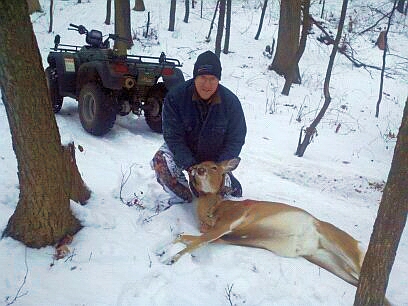
I’ve divided this post in two sections. Part 1 describes the “hunt†and Part 2 provides some details on the rifle. The entire piece is rather lengthy so I’ll get you all started and then insert one of those “below the fold” thingydoos so as to keep the front page real estate usage down. and those of you who are still interested in reading can do so.
Part 1:Â The Hunt
I live in the southern portion of Michigan’s lower peninsula which, for those of you who may not be familiar with our state hunting rules, requires the use of either a shotgun shooting slugs or a muzzleloader during deer season. That is the area below the blue line in the map.
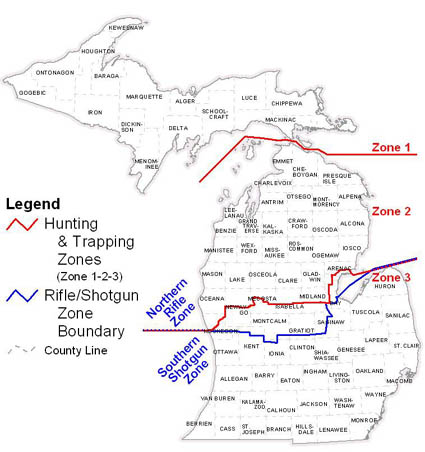
I believe this decades-old rule is based on the assumption that a modern centerfire rifle has a velocity much faster than that of the aforementioned shotguns and muzzleloaders. Add to this the generally accepted truth that the population density is greater in southern Michigan and you arrive at the long standing rule of no centerfire rifles allowed during deer season in my neck of the woods. When the rule was established, and I am guessing here, the premise was that muzzleloaders were of the flintlock and lead ball variety with lower velocity and therefore posing less risk to others. Advancements in firearms technology have, in my opinion, surpassed the intent of the rules as I am using a modern muzzleloader which will push a saboted 275 gr. bullet out the barrel at velocities up to 2400 fps!
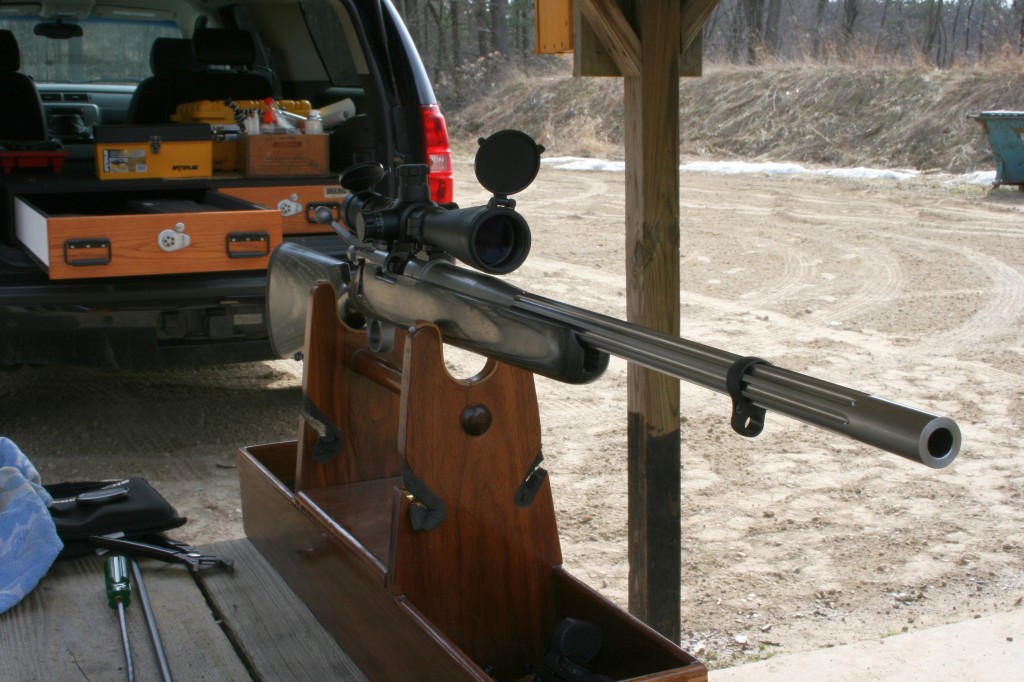
According to the rules, I cannot use one of my circa 1870’s single shot black powder cartridge rifles which, at around 1100-1200 fps., have a muzzle velocity of about half that of my muzzleloader. All because they load from the breech and use a brass case and primer. Go figure. I would love to use my Shiloh Sharps or Remington Rolling Block to lob a 535 gr. slug of 45-70 lead at Bambi’s sibling or progeny next year. Umm, in the interest of blogophistic accuracy, progeny no longer applies.
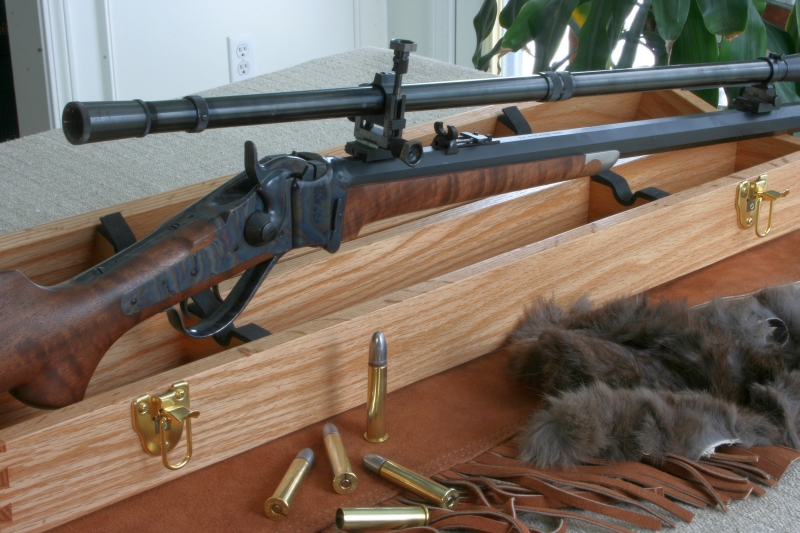
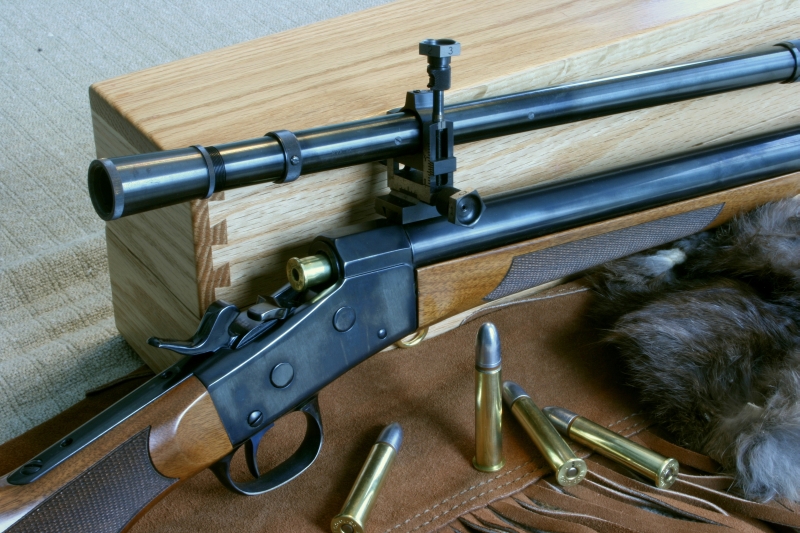
I would love to regal you all with a classic tale of how I was able to spot the biggest buck in the county and proceed to track him for 4 hours through the roughest brush and woods that Michigan has to offer. And then sneak up close for the kill without being detected. Not even close!
To begin with, I was carrying an antlerless deer license. That means a doe, not a buck. I purposely purchased this type of license because I’m not interested in hanging a head and antlers on a wall. I was interested in meat only and I had been told by others that doe meat was tastier than guy meat, thus the antlerless license. Sticking with the central theme for this whole experience of harvesting a deer for the first time, I wanted to shoot it, gut it and have the animal’s meat processed and stockpiled in my home. Whenever I discussed shooting a deer with friends, I would always joke and say that my motive was to ensure that I could accomplish these steps on my own and not starve should the SHTF and the local supermarket wasn’t up and running with the weekly special on ground round. In an actual SHTF scenario, I’m still way behind the curve, but I feel like I’ve at least left the starting line.
As to the actual environment I was in, a friend of mine has 5 acres on which he resides, most of it woods. He’s known that I’ve been interested in getting a deer and he invited me to try my luck at his place. He has harvested one or more each year for some time on his property. It is a great location for deer as the rear section beyond his grass backyard, is wooded with a ravine running across. Beyond his rear property line at the far side of the ravine, is a large farm with a cornfield. The conditions are perfect for the deer to eat, sleep, walk around and do deer stuff. They have a hankering for using the ravine as a travel route and can be seen most every day. Hell, they often come up into the yard right up to the house and eat/wreck the shrubbery. My friend’s wife was very eager to have me shoot one. I think her words were something like “Kill ‘em. I hate those #@%&$*(!
As I mentioned at the beginning, this took place the Monday before Christmas and the ground was snow covered. I actually preferred it this way for two reasons. One, the deer stand out against the white background and if one has to follow a blood trail, it seemed to me that it would be easier in the snow. My friend suggested I arrive at his place around 6 AM and get set up by 6:30.
Now this part about getting set up is where I take issue describing my activity as hunting and the basis for my wording the title for this post as I did. Included in my gear was a folding chair that I set up at the top of the ravine and I simply plopped down into it with the rifle loaded, primed and ready to go, safety on. I have a hard time saying that I was hunting when I’m comfortably sitting in a chair waiting to ambush an animal 50 yds. away and can then leisurely walk 40 yds. back up to the house and partake of some hot cocoa and warm up.
I sat for a while, staying moderately warm and enjoying the transition from dark to first light followed by sunrise. The sounds changed over the course of my sitting there, at first just the wind and branches creaking. That was followed by the chatter of some squirrels that got up and began their day running up and down tree trunks, as well as the chirping of birds that are too stupid or are genetically limited from flying to Florida in December. Later there was a small woodpecker working on a section of a dead tree with the constant tap tap tap narrating his efforts. I mention these sounds because I always wear ear protection and this morning was no different. I was wearing my electronic ear muffs over my knitted hat with the volume turned up so the sounds around me were quite noticeable. Geeky to look at, but I value the hearing I have left and I wasn’t looking in a mirror anyway.
At the first hint of light, I thought I started seeing shadowy shapes move around down in the ravine. I wasn’t sure if I was really seeing these or if my eyes were playing tricks. I lifted the rifle to my shoulder and viewed the scene through the scope. There were deer moving. I could see deer shapes, but not with enough contrast to confidently place the reticle on the shoulder for a heart/lung shot. I gently clicked off the safety and . . . . . . . everyone scattered!! The little click was loud enough to alert them and they quickly decided to be somewhere else. Not a big problem though, as it was still not light enough to be within the dawn to dusk window allowed by the DNR. I did make a mental note that I might try and do something to quiet the safety mechanism in the future. I lowered the rifle back to my lap and waited.
Waiting in the chair for another half hour or so, the light became a bit brighter and with things on my end quieted down and enjoying the stillness, it wasn’t long before more shadowy shapes again appeared. They were moving up the ravine, checking the floor of the woods for munchies and not paying me any mind. I should mention that I didn’t have any scent blocker spray or similar precautions taken. In fact I had just stopped at McDonalds and eaten two Egg McMuffins prior to arriving at my friend’s place. The deer didn’t seem to object to my breath, though maybe I was just lucky that I was on the eastern slope of the ravine and the wind was predominantly out of the west, allowing me to be downwind of them. There were about six deer in the group making their way up the ravine. They would walk a bit, stop, lower their head to the ground to check something out, raise back up and walk a bit again. All but one were blocked by tree trunks or branches from my taking an easy shot. There was a single doe which stopped and was grazing right in the middle of the best shooting lane available, that being directly in front of my position. She was standing perfectly broadside to me. I slowly raised the 12 lb. rifle to my shoulder and that small movement must have made just enough noise with my jacket fabric rustling a bit, as she raised her head and assumed the alert position. This was perfect for me as the light was now sufficient to readily see the reticle against her shoulder. I had sighted the rifle in at 50 yds. two months earlier in October in warmer weather and I was silently entreating the hunting gods to please let the change in conditions not be enough to throw off the shot. I took a breath, let some out, held it, slowly squeezed the trigger and it broke with the reticle right on the shoulder. Through the cloud of black powder I could see the animal fall right where she stood, not taking so much as a step. I watched for a while for any signs of movement but there were none. My initial thought was wondering if it was a clean kill and then some relief that there wouldn’t be a need for my wounded deer tracking skills this day. I was confident that she was dead so I gathered up the chair and walked back to my truck and took off some outer layer clothing, put the rifle away and proceeded to walk back to my friend’s house and warm up.
My buddy had to drive his kids to school, so I waited until he returned to get the deer and do the messy stuff.   We walked down to the deer. Actually I walked down to the deer. My friend drove his ATV to use to haul it up to where I would clean it. Upon close inspection, my shot had gone right where I had aimed, into the right shoulder and out the left. I would see later, during the gutting process, the bullet had torn the top of her heart off.
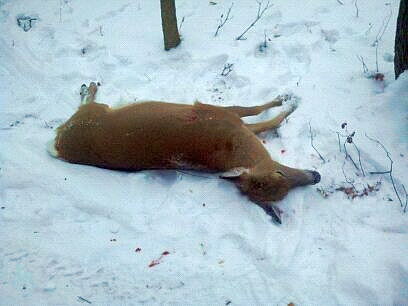
We hauled the deer up the hill and placed it onto a tarp I had spread out on his driveway. He had asked me to bring a tarp to use in cleaning the deer. That way we could gather the discarded parts and wrap them up and put the entire tarp and parts into a large garbage bag so his yellow Lab wouldn’t get into them.
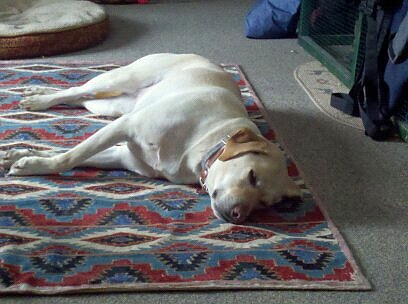
He began talking me through the process of gutting the deer. I had put on some shoulder length disposable plastic gloves, as I would be reaching inside the carcass and would not want to stain my regular shirt or jacket, not to mention bacterial type nasties. First up, I used a marvelous gadget he had that made disconnecting the anal alimentary canal from the animal very easy. This is one instance where the name of the tool aptly fits the tool’s use. It is called the Butt Out tool, available at establishments that cater to hunters.
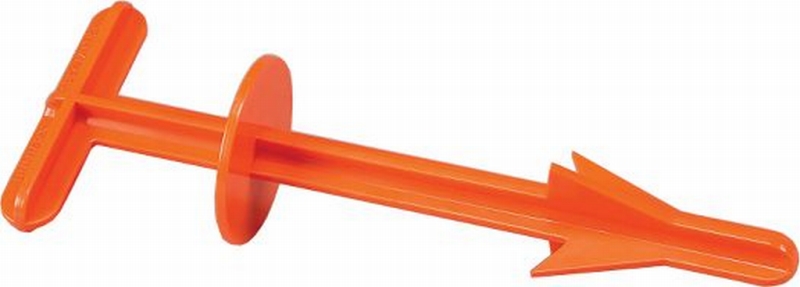
The tool is jammed up the anal canal to the stop and then turned a few times to allow the barbed tip to grab the membrane. Then you just pull it out and the anal canal turns inside out and comes out with it. You pull it out so that the membrane is stretched tight and then tie it off with some string right against the body. Then cut the membrane off outside the tightened string. After that the part that remains inside the animal can be grabbed and the canal section that was tied off can be pulled back in through the pelvis and into the body cavity where it and the rest of the innards are cut and removed.
My friend continued to guide me through the remaining steps and I finished up with the gutting. I was not sure how I would react to the gutting process.  It was messy of course and a bit smelly, but not all that bad. I can see where it would become a very routine exercise once one has done it a few times. We tidied up the area and lifted the carcass onto his trailer and hooked it to my truck.   We then drove to the processor that my friend uses and I spent a bit of time with the clerk asking questions and finally settling on my order. I don’t have any fantastic venison recipes stowed away, so I kept things very simple. I learned that the back strap portion was very tender, the clerk likening it to beef filet mignon. Since I love good beef, this sounded like good stuff to have. I passed on any roast, steaks or burger. The remainder, after the back strap, was made into jerky (mildly seasoned) and a pantload of snack sticks in three flavors: mildly seasoned, with cheddar cheese and a batch with cheese and blueberry. I am a blueberry addict and often eat a pint of fresh berries at one sitting, so the blueberry inclusion was a no brainer. The clerk offered samples of each and I enjoyed them all. The next thing on the agenda was to determine where I was going to be keeping all this additional meat. Never having done this before, I had no idea of what the final volume of meat one deer would generate. I went to the local Lowes and bought a chest freezer and had it delivered before the meat was finished at the processor. As it turned out, the volume was more than the freezer section of the frig/freezer in the kitchen would hold, but less than what I imagined at the beginning of this affair. The final tally was 5 pkgs. of back straps, 2 five-pound pkg. of jerky, and 32 bags of snack sticks in the 3 flavors:
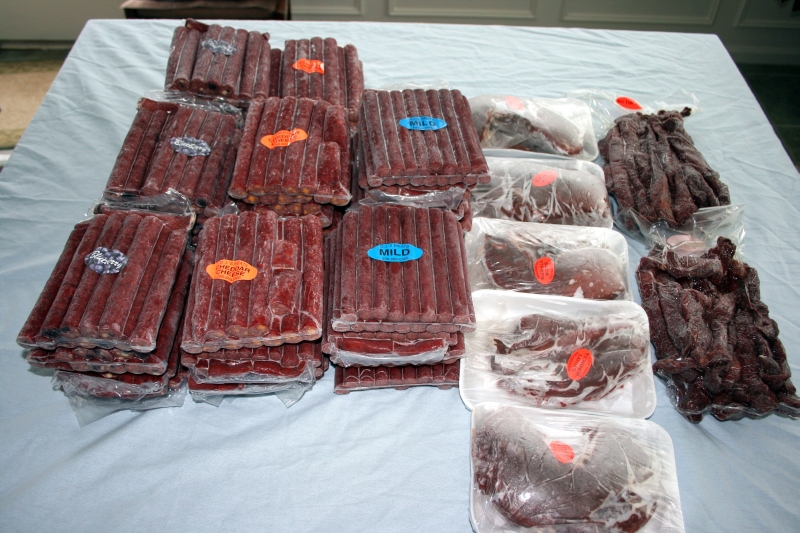
My dear wife who hates “dead things” isn’t planning on eating any of the “harvest”, but I know someone who is more than willing:
“You’re planning on sharing, right?”
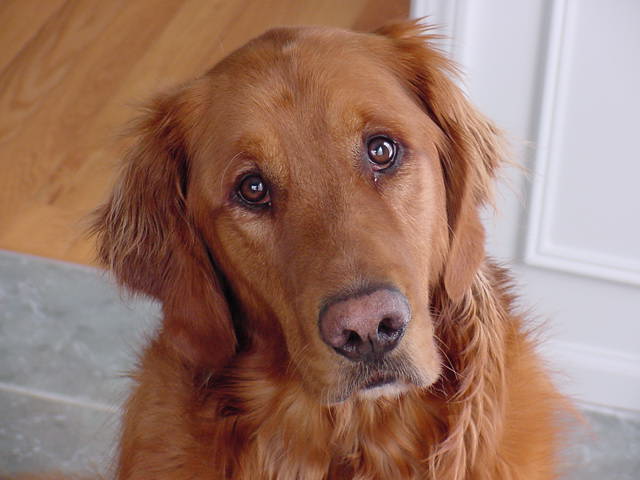
All in all, it was a very interesting experience. I still don’t consider myself a hunter, as there’s no stalking involved, but I’ll keep my folding chair ready for next December. By then I will have had an opportunity to research some good recipes for roasts, steaks and burger. Or maybe I’ll stick with the snack sticks as they are tasty.
Part 2:Â The Rifle
My muzzleloader is a product of Ultimate Firearms, Inc., based in mid-Michigan.
The action is a Remington 700. The free-floating, fluted stainless barrel is from Lothar-Walther in Germany. The stock is a pepper colored laminated sporter from Accurate Innovations containing a full length black anodized aluminum chassis.
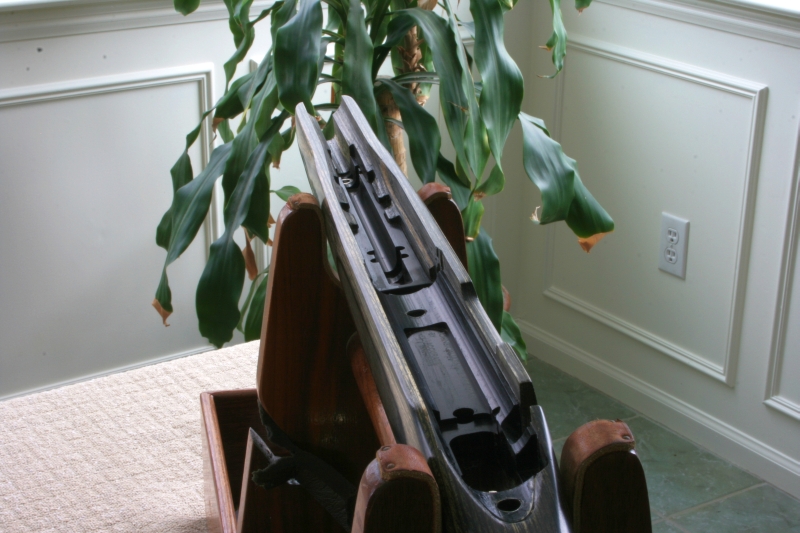
A Leupold 3.5 x 10 Mk4 Tactical scope sits atop the receiver. (because you never know when you are going to encounter a tactical doe when hunting regular ones)
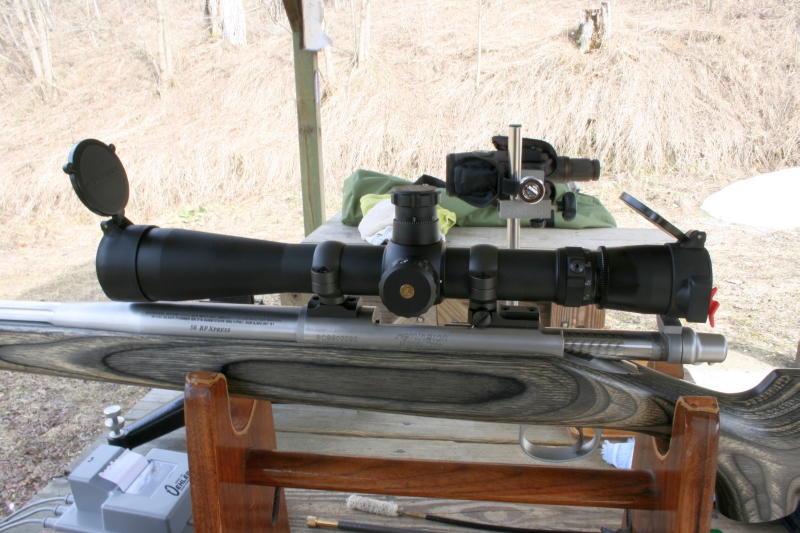
The elevation knob is a custom piece marked such that when initially set up and sighted in at 200 yds., the knob is set at ‘2’. To move to 400 yds., the knob is turned counterclockwise from ‘2’ to ‘4’. The users’ guide says to sight the rifle 3 ½†high at 100 yd. and it should be dead on ar 200 yd. For my 50 yd. sight-in, I moved the knob in the opposite direction to move the point of impact to the appropriate position.
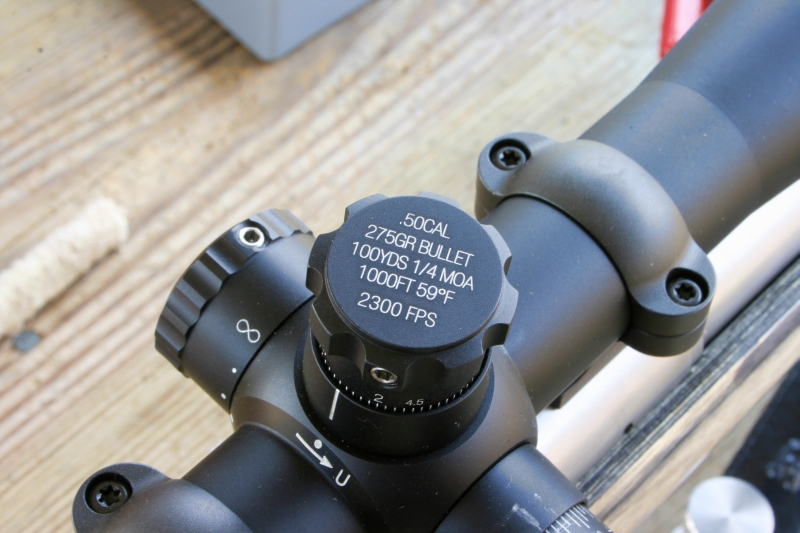
The rifle is not in the featherweight class, weighing 12 lb. with scope mounted. A unique feature of this rifle is the breechplug nipple and primer execution. Instead of the commonly used 209 shotgun primer and cup used on many modern in-line muzzleloaders, this breechplug nipple is machined to fit a Starline .45 Win Mag brass case.
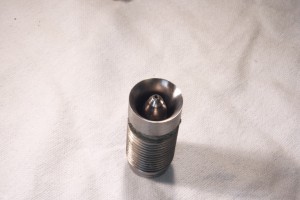
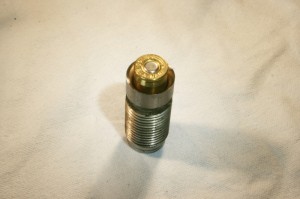
These cases are dimensionally similar to the .45 ACP but 0.30†longer. The primers used are Large Rifle Magnum.
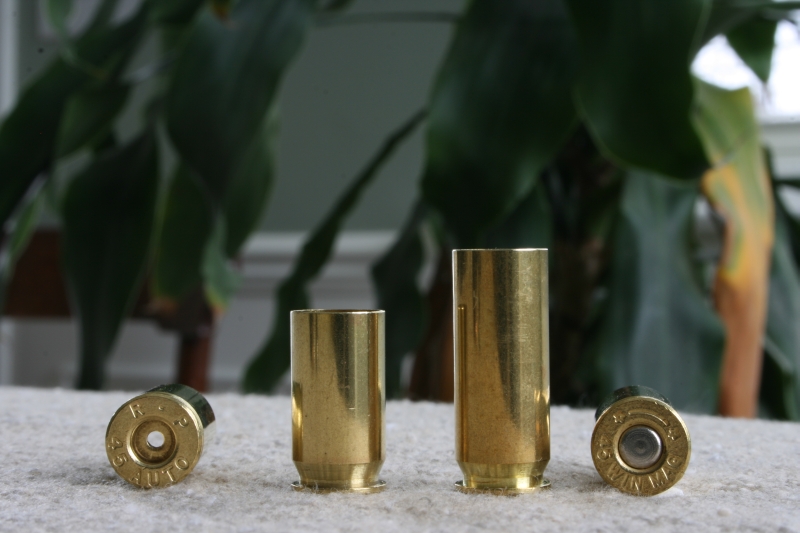
The primed brass case is simply laid into the receiver channel ahead of the bolt, the bolt closed as in any bolt action and the brass case slides over the nipple.
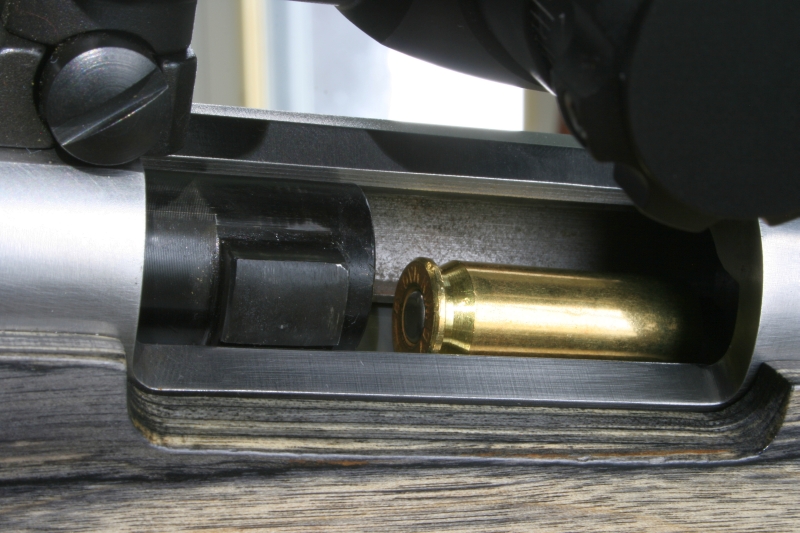
The manufacturer’s web site claims that the large rifle magnum primer burns 10x hotter than a 209. Their recommended loads are up to four Hodgen triple ‘se7en’ 50 gr. black powder substitute pellets or three Hodgen triple ‘se7en’ Magnum pellets.
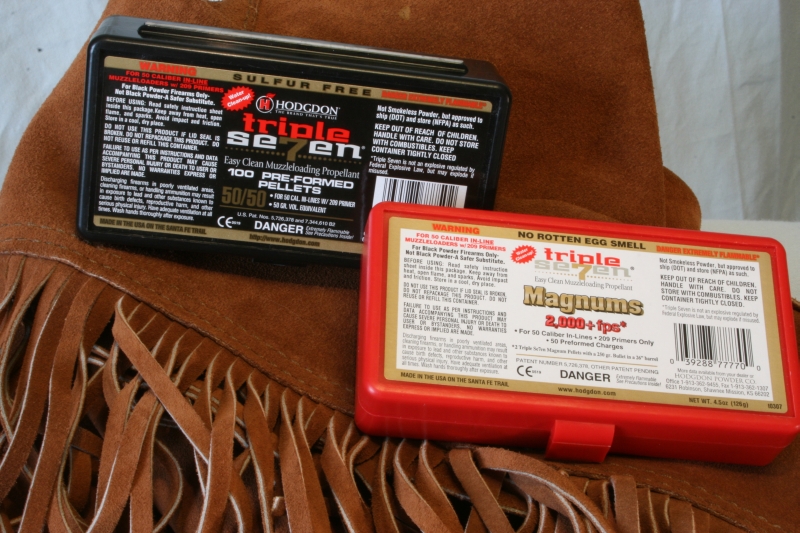
The trigger pull measured an average of 3 lb., which was fine by me for shooting at deer, though quite heavy by target shooter standards.
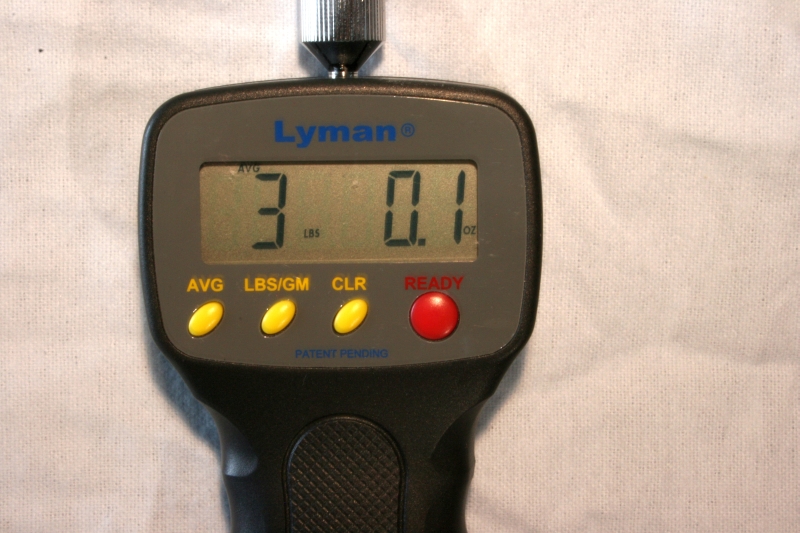
Last March, I took the rifle and my Oehler chronograph to the range and spent the afternoon trying different loads at 50 and 100 yds. I settled on using 3 pellets of Hodgen triple ‘se7en’ Magnum with the 275 gr. saboted bullet as my “standard†load. This combination turned out to be more cost effective than using 4 standard 50 gr. pellets. A box of magnum pellets costs more, but on a per load basis, 3 magnums total less than 4 regulars). This wasn’t the highest velocity possible, but would certainly be adequate for Mr. or Ms. Deer in the coming season. The load I was using matched with the load vs. velocity chart supplied by the manufacturer.
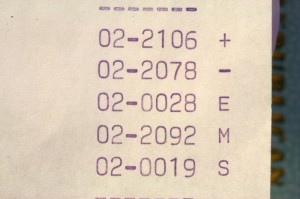
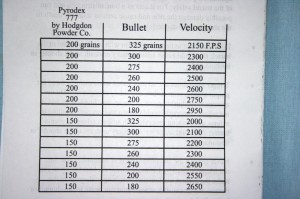
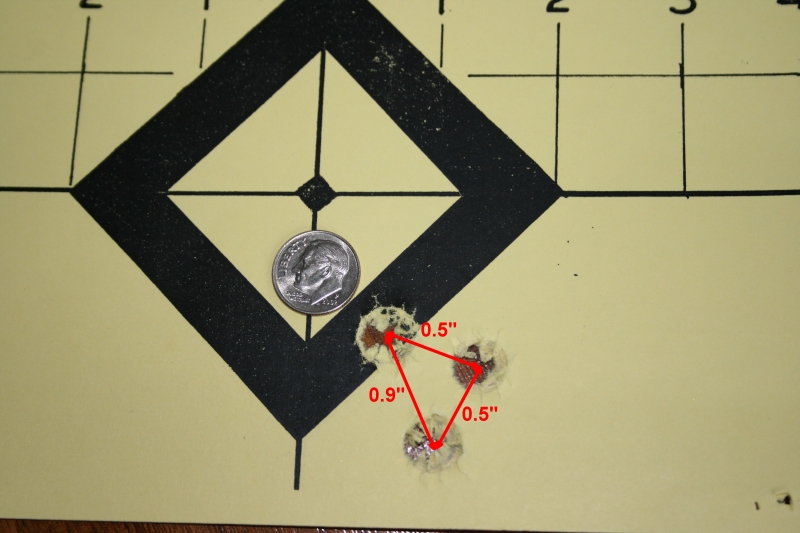
The accuracy was within minute of deer.
Disclaimer: I was a real dumbass and didn’t write the yardage on the target, so I cannot say with certainty whether it was shot at 50 yd. or 100 yd. As geeked as I would be for this to have been be a 100 yd. group, I’ll err on the conservative side and say that it’s well within Minute of Deer at 50 yd.
I’ve since obtained different colored heavy paper stock for my targets and have 4 colors that I use at 50, 100, 200 and 300 yds. at my gun club range. I won’t be trying to remember at which yardage I stapled a target to a backstop anymore.
I’ll finish up with a little side story on the subject of a lesson learned about being lazy and consequences thereof. On that March 2010 day, I was firing the new muzzleloader for the first time. At my gun club’s 100 yd. range, it is possible to set up portable target stands at 50 yd. I decided to try and save time and effort by setting the sky screen stand such that I could shoot at both the 50 yd. targets and the 100 yd. targets without moving the sky screens. The view through the scope shows the setup.
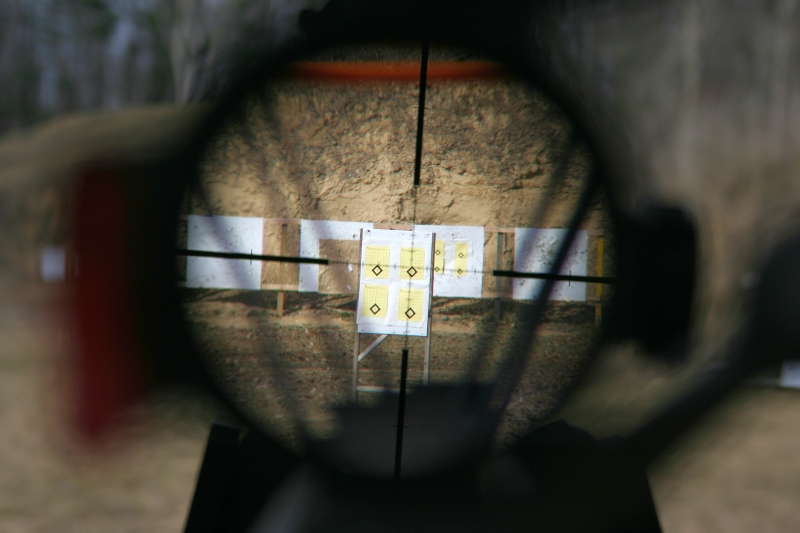
The recommended distance from the muzzle to the first sky screen is 10 ft. I use a pair of spring clamps with 10 ft. of para cord to quickly set the distance from the sky screen stand to the rifle muzzle.

After setting the stand, I proceeded to shoot at both distances and it seemed to be working out just fine. I was cruising along making the shots, cleaning the bore between shots and generally enjoying a nice afternoon with the new rifle. Before long, I noticed that the chronograph tape was looking funny. Funny, as in screwy results. The Oehler uses 3 sky screens which allows for a dual or what they refer to as a ‘proof’ reading.
It’s like having 2 chronographs, one right after the other. As long as both sections read within an acceptable range, the system considers the reading valid and does the normal computations for fps, high/lo, spread, mean and standard deviation. If one section’s reading is funky, then the result is void, even if the other section grabbed an accurate number. I was puzzled at first, looking at the tape, but finally saw what the problem was . . . . .

Yep, my desire to avoid the effort to get up and move the sky screen stand each time I switched from 50 yds. to 100 yds. came back to bite me. Viewing both target sets with the same sky screen stand position worked for a while, but then it didn’t. The damage wasn’t confined to the skyscreen only. The photocell housing was damaged as well.
The end result was that I went home, phoned Oehler and ordered some extra pieces. They stopped selling the Model 35 system to retail customers a few years ago, but were still supplying parts at the time of this range session. [Update:Â I read where Oehler is again selling the Model 35 to the retail market.]
Lesson learned. Wait . . . . maybe not. I still want to avoid getting up from the bench and stepping in front of the firing line to move the sky screen stand, so now I am sitting in my chair looking outside with temp around 14º and snowing . . .
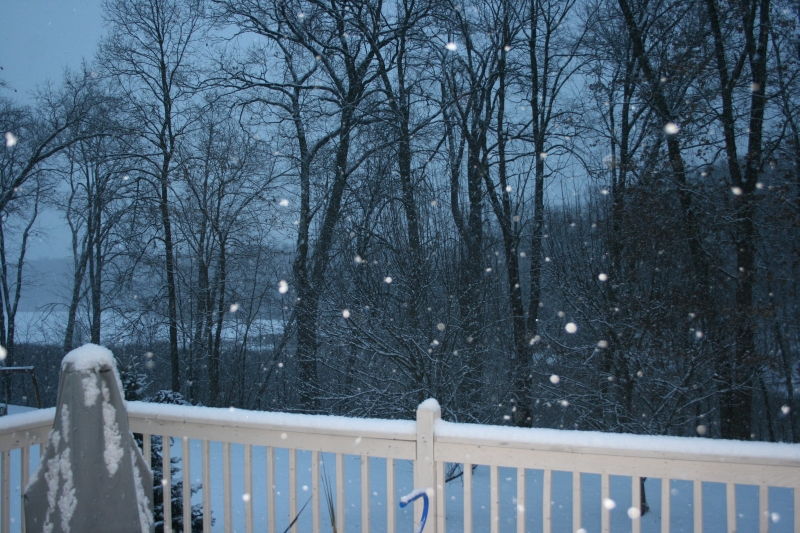
There are images in my head of the sky screen stand making small movements to the left or right, up or down at the press of a finger on a control box situated on the shooting bench. I’m seeing small 12V DC motors, servos, threaded rods, linear motors, bearings, rocker switches and more swirling around in my head. Hmmmmmm.Â
Later.

WAHOO! Great post, great photos, and very cool venison!
Readers, I’ve been hearing Dave telling versions of this post more than once over the phone and at Boomershoot, and the frustration with not being able to post pics was very evident in his voice. Worth the wait, I think.
Oh yeah, “Bushwhacks.” — resident grammarian Davidwhitewolf.
Good Job!!
Now to the burger. I save the backstraps cut in half (four total) and have all the rest ground into burger with 10% beef tallow added. Best burger you’ll ever have…good for grilling burgers, chili, sphagetti sauce, etc.
HTH
Nothing in the world like eating something that you harvested, or bushwhacked, yourself. Good call on the doe tag. I always prefer them to general tags. The does seem to be a little better eating than the bucks. I have nothing to prove that, just an opinion. As to recipes – if you own a grill and a salt shaker, you have everything you need to enjoy a good venison steak, or a venison burger. Or you can fancy them up a bit with sauces and marinades if you wish. Experiment a bit to find out what goes best with the gamey taste. I prefer just a little salt. Treat it like really lean beef. Because it’s wild, make sure it is cooked through, but don’t overcook it. I prefer my red meat med-rare, but eat my game meat – medium – just as it losses the pink color.
Dad and I used to butcher our own – so everything was either cut into steaks, ground into burger, or jerked. Some of my best childhood memories was Dad wheeling the grill around to the garage door, so we could be grilling the backstraps while cutting up or grinding everything else. Dad started with a few pieces of backstrap for the two of us and we enjoyed them with a little salt and served on a fork. We’d take a short break, lean against the table and savor the first bites of our labors. Then it was back to work – for some reason I always ended up cranking the damned grinder. Dad was great at timing the grill so that dinner was cooked just about the same time the rest of the meat was packaged, in the freezer and our mess cleaned up.